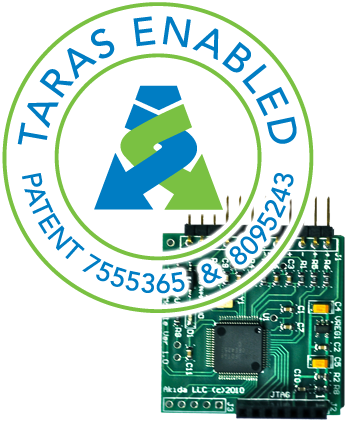Technology
Energy Management
We have considerable experience and expertise in electrical energy monitoring and have developed the TARAS energy efficiency technology (patent 7,555,365 & 8,095,243 and others pending) for acquisition and transmission of electrical energy related data. Our fundamental approach is to provide real-time data on more than fifty parameters for electricity for discrete electrical equipment, within a two-way communication network and built-in hardware for a programmable control option. Examples of data that is available: Kilowatts hour; Active Watts; Reactive Watts; Apparent Watts; Voltage; Current; Frequency and Power Factor. We recognize that specialty SAS firms have already made great investments in user interfaces and analytics but there has been little or no development of more efficient hardware for collecting data. We welcome partnerships with others for the user interface and remain focused on delivering the most advanced and cost-effective hardware and data network platform. TARAS provides an easy installation, low-cost solution for managing energy consumption and monitoring heavy equipment. Demand charges on electricity rates have increased substantially and management of these demand charges is a new and rapidly growing service area. Utility companies are emphasizing peak demand costs since market deregulation has made spot market purchase of electricity very expensive and distributed renewable energy generation has compounded this problem. TARAS is a digital system and it is IOT ready, allowing two-way communication for monitoring and control and the ultimate smart-grid system.
Technology
TARAS – Digital Electrical Metering card
Our TARAS energy efficiency technology is available in a handy card format so that it can be easily integrated into any electronic hardware design that requires accurate on-board digital electrical metering. The TARAS card uses standard pin connectors to integrate into a PCB and is furnished with its data protocol so that hardware developers can communicate with it directly to provide readings from sensor coils and receive the energy data readings from the card. More than fifty attributes related to electricity can be monitored depending on the level of granularity and detail desired. Many of the attributes provide a measure of how the equipment is performing and if maintenance is needed and would therefore be useful for an analytics platform. Additionally the TARAS card’s on-board intelligence can relay commands directly to the load to reduce or terminate the energy consumption. The data packets from the card are in a digital format so that they can be directly input into software platforms for analytics and system controls to allow intelligent energy management decisions. This means, minimal hardware design is needed to provide the connectivity to the sensors and a system’s data processing center.
Perfect for OEM’s: The TARAS technology is perfect for OEM’s who desire to build cost-effective energy and performance monitoring into their electrical products. More than fifty attributes related to electricity are monitored and many of them provide an indicator if maintenance is needed and would be very useful to the OEM’s customer. TARAS allows two-way “open” communication therefore the OEM will benefit from providing electrical equipment that can be managed via most energy management software systems.
The TARAS card also reduces the cost of sub-metering panels and simplifies the installation of these systems.
Open two-way communication=Easy system integration: A unique aspect of the TARAS technology is that additional signals from remote sensors such as vibration sensors can be channeled through the card and be included in the data network protocol for easy viewing and analysis via end-user software. The TARAS technology’s open source communication protocol allows system integrators to communicate with the hardware and allows easy incorporation of the technology into existing platforms.
